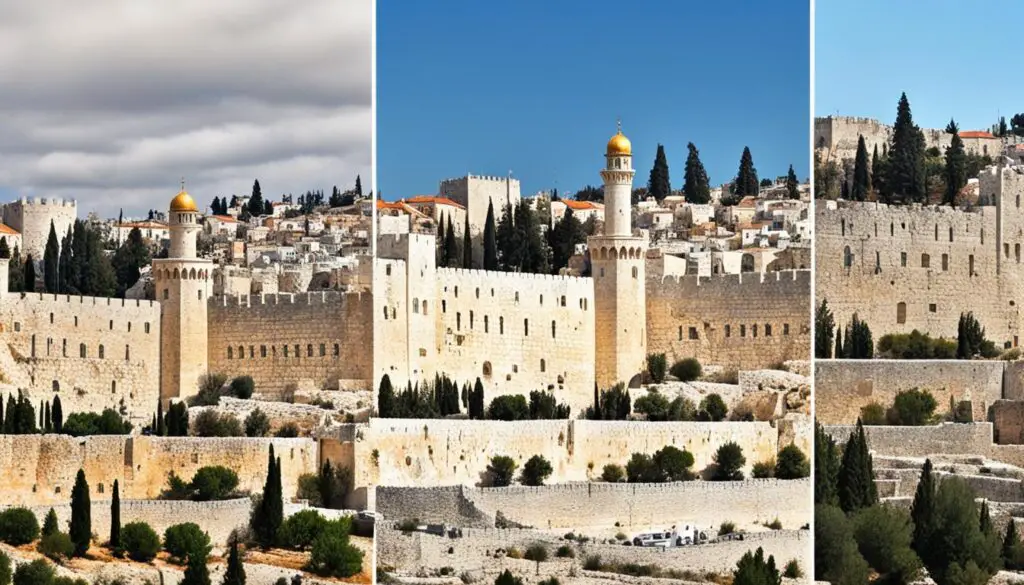The Walls of Jerusalem hold immense historical significance and offer a unique opportunity for exploration. Whether you are a history enthusiast or a nature lover, the Walls of Jerusalem are a must-visit destination that encompasses both the rich cultural heritage and the breathtaking natural beauty of the region.
Exploring the Walls of Jerusalem allows you to immerse yourself in centuries of history. From hiking along the ancient paths to camping amidst the serene surroundings, every step unveils the stories and secrets that the walls have witnessed over time. Amidst the towering structures, you can marvel at the architectural brilliance and appreciate the historical significance that has shaped the city.
Not only do the Walls of Jerusalem offer a glimpse into the past, but they also provide a haven for flora and fauna. As you traverse the paths, you will encounter diverse ecosystems, showcasing the natural beauty that thrives within the walls. From vibrant blooms to elusive wildlife, the walls are a treasure trove of biodiversity waiting to be explored.
Camping in the vicinity of the Walls of Jerusalem allows you to connect with nature and experience the tranquility that surrounds you. Fall asleep under the star-studded sky, and wake up to the awe-inspiring views that the walls offer. It is a unique opportunity to disconnect from the bustling city life and find solace in the embrace of history and nature.
The Walls of Jerusalem are not just ancient structures; they are a testament to the cultural heritage of the region. Their historical significance and captivating beauty make them a must-visit destination for all those seeking an enriching and unforgettable experience. Plan your visit and embark on a journey through time, immersing yourself in the stories that unfold within the walls.
Key Takeaways:
- The Walls of Jerusalem have immense historical significance and offer a unique opportunity for exploration.
- Exploring the walls allows you to immerse yourself in centuries of history and appreciate the architectural brilliance.
- The Walls of Jerusalem are home to diverse flora and fauna, showcasing the natural beauty of the region.
- Camping near the walls provides a chance to disconnect from city life and embrace the tranquility of nature.
- The walls are a testament to the cultural heritage of the region and a must-visit destination for history enthusiasts and nature lovers.
Ancient History of the Walls of Jerusalem
The story of the Walls of Jerusalem dates back to ancient times, with a rich history spanning centuries. The construction of the walls can be traced back to the Canaanites, who built the first fortifications to secure the city. However, it was under the rule of King David that Jerusalem truly began to take shape as a fortified capital.
After capturing the city from the Jebusites, David expanded the walls, establishing Jerusalem as the City of David. The walls provided protection and security for the growing population, as well as a symbol of strength and authority.
Solomon, David’s successor, made significant contributions to the Walls of Jerusalem by constructing the magnificent Temple Mount within the city. The Temple Mount became the center of religious and cultural life, drawing people from far and wide.
Throughout the centuries, Jerusalem faced numerous threats and invasions, which led to the fortification of the city walls. King Hezekiah, during the reign of the Kingdom of Judah, further expanded and reinforced the walls to protect the city from the Assyrian Empire.
Later, after the Babylonian exile, Nehemiah played a crucial role in the restoration and reconstruction of the walls. His efforts ensured the safety and stability of Jerusalem, allowing the people to once again thrive within its protective walls.
The Hasmoneans, a Jewish dynasty that ruled during the Maccabean revolt and subsequent period, also contributed to the fortification of the Walls of Jerusalem. They fortifed the city to defend against external threats and maintain the integrity of Jewish sovereignty.
During the reign of King Herod, the Walls of Jerusalem underwent extensive renovations. Herod, known for his architectural prowess, added grandeur to the city walls, constructing magnificent towers and gates that showcased his power and the city’s prominence.
Continuing the tradition of fortification, Agrippa I, a later king, constructed a third wall to protect the expanding city and accommodate its growing population.
This rich history of construction and expansion demonstrates the importance placed on the Walls of Jerusalem throughout different periods. These walls served as a physical barrier against invaders, a testament to the city’s strength and resilience.
Timeline of Ancient History of the Walls of Jerusalem
| Period | Key Figures | Contributions to the Walls |
|---|---|---|
| Canaanite Period | Canaanites | Initial fortification of the city |
| Davidic Period | King David | Expansion and establishment of Jerusalem as the City of David |
| Solomonic Period | King Solomon | Construction of the Temple Mount within the city walls |
| Hezekian Period | King Hezekiah | Expansion and reinforcement of the walls to protect against the Assyrian Empire |
| Post-Exilic Period | Nehemiah | Restoration and reconstruction of the walls |
| Hasmonean Period | Hasmoneans | Fortification to defend against external threats |
| Herodian Period | King Herod | Extensive renovations, addition of towers and gates |
| Agrippian Period | Agrippa I | Construction of a third wall |
Modern History of the Walls of Jerusalem
In the 16th century, the Ottoman Empire ordered the rebuilding of the walls of Jerusalem under the reign of Suleiman the Magnificent. The walls were completed in 1538 and have remained largely unchanged since then.
“The rebuilding of the Walls of Jerusalem was a significant undertaking, reflecting the Ottoman Empire’s investment in fortifying the city. Suleiman the Magnificent’s reign marked a period of stability and prosperity, and the new walls stood as a testament to his power and influence.”
The walls of Jerusalem served as a defensive stronghold, protecting the city from external threats for centuries. Today, they stand as a remarkable example of Ottoman architecture and engineering.

The Walls of Jerusalem were recognized as a UNESCO World Heritage Site in 1981, along with the Old City of Jerusalem. This designation highlights the cultural and historical importance of these iconic walls, drawing visitors from around the world to experience their grandeur and significance.
Suleiman the Magnificent and the Rebuilding of the Walls
Suleiman the Magnificent, the longest-reigning Ottoman Sultan, took a keen interest in fortifying and expanding the empire’s boundaries. Under his leadership, various construction projects were undertaken, including the rebuilding of the Walls of Jerusalem.
The restoration of the walls was not merely a defensive measure but also a symbol of the empire’s might and control over the city. The construction process involved skilled craftsmen and engineers, resulting in the meticulous reconstruction of the walls.
UNESCO World Heritage Site
The Walls of Jerusalem, along with the Old City, were designated as a UNESCO World Heritage Site in 1981. This recognition symbolizes the global importance of these historic walls and their impact on human civilization.
The UNESCO World Heritage Site status ensures the preservation and protection of the Walls of Jerusalem for future generations. It also underscores the responsibility of society to safeguard these invaluable cultural treasures.
Modern History of the Walls of Jerusalem
| Year | Event |
|---|---|
| 16th century | Rebuilding of the walls under Suleiman the Magnificent |
| 1538 | Completion of the rebuilding process |
| 1981 | Recognition as a UNESCO World Heritage Site |
Structure of the Walls and Gates
The Walls of Jerusalem are an impressive architectural feat, stretching for 4,018 meters and standing at an average height of 12 meters. These sturdy walls have an average thickness of 2.5 meters, serving as a testament to their historical significance and enduring strength.
Watchtowers play a crucial role in the defensive system of the Walls of Jerusalem. A total of 34 watchtowers are strategically positioned along the walls, providing vantage points for surveillance and protection.
The Walls of Jerusalem are adorned with several main gates, serving as primary entry points for traffic. These gates offer both historical and practical significance, allowing visitors to access the city and explore its wonders. The seven main gates include:
- Jaffa Gate
- Zion Gate
- Dung Gate
- Golden Gate
- Lions’ Gate
- Herod’s Gate
- Damascus Gate
In addition to the main gates, two minor gates have been reopened by archaeologists, providing access to specific areas of interest. These gates offer a glimpse into the historical and cultural heritage of Jerusalem, allowing visitors to step back in time and explore the city’s past. The two minor gates are:
- Huldah Gate
- New Gate
Together, the watchtowers and gates form an intricate network of defense and access points, preserving the history and charm of the Walls of Jerusalem.

| Structure | Dimensions |
|---|---|
| Total Length | 4,018 meters |
| Average Height | 12 meters |
| Average Thickness | 2.5 meters |
| Watchtowers | 34 |
| Main Gates | 7 |
| Minor Gates | 2 |
Pre-Israelite and Israelite City Walls
The Walls of Jerusalem hold a significant place in history, dating back to the pre-Israelite city of Jebus. This fortified city eventually became known as the City of David during the rule of David, the legendary king of Israel. Under David’s leadership, the Israelites expanded the walls to encompass the sacred Temple Mount, where Solomon later constructed the magnificent First Temple.
During the First Temple period, the walls underwent further extensions to accommodate the growing population of the city. These walls served not only as a physical barrier but also as a symbol of power and protection for the Israelite city.
“The Walls of Jerusalem stand as a testament to the resilience and ingenuity of the Israelite people. They reflect the grandeur of a civilization deeply rooted in its faith and heritage.”
Today, the remnants of the pre-Israelite and Israelite city walls offer a glimpse into the past, allowing visitors to connect with the rich history of Jerusalem. The majestic Temple Mount, surrounded by these ancient walls, remains a sacred site for worshippers and a place of awe-inspiring beauty.

Dimensions and Features of the Pre-Israelite and Israelite Walls
| Period | Dimensions | Main Gates | Minor Gates |
|---|---|---|---|
| Pre-Israelite | N/A | N/A | N/A |
| Israelite | Height: Varies, with an average of 8 meters Thickness: Varies, with an average of 3 meters |
Golden Gate Huldah Gates Dung Gate Jaffa Gate |
Water Gate Silos Gate |
Jerusalem in Jesus’ Day
In Jesus’ day, the walls of Jerusalem remained the same as those expanded during the Hasmonean period. These walls not only served as a physical barrier to protect the city but also played a significant role in the events surrounding Jesus’ life and ministry.
One iconic location within the city was the Citadel, which marked the western limit of Jerusalem during that time. The Citadel, also known as the Tower of David, is a fortified structure that has witnessed centuries of history. It is believed that this location, within the walls of Jerusalem, was where Jesus was crucified.
The walls of Jerusalem acted as a backdrop to the crucifixion of Jesus, providing a solemn and powerful setting for this pivotal moment in Christian history. The city walls, with their grandeur and majesty, added to the significance of Jesus’ sacrifice.
“As Jesus hung on the cross, the walls of Jerusalem stood tall, bearing witness to the crucifixion and serving as a reminder of the profound impact Jesus had on the world.”
The Walls of Jerusalem in Jesus’ day encapsulated the historical and spiritual significance of the city. The events that took place within these walls continue to resonate with believers around the world, making Jerusalem a cherished place for Christians and people of various faiths.

Changing Fortunes and Renovations
The walls of Jerusalem have witnessed a tumultuous history, marked by both destruction and restoration. The city’s walls suffered significant damage during the Roman sieges, leaving the once-mighty fortifications in ruins for several decades.
However, under Byzantine rule, a concerted effort was made to rebuild and strengthen the walls. Extensive renovations were undertaken, ensuring that the walls regained their former strength and grandeur.
Throughout the centuries, the walls of Jerusalem experienced multiple occupations, each leaving its mark on the city’s defenses. The Moslems and Crusaders both made their own modifications to the city walls during their respective occupations, further shaping the fascinating architectural landscape of Jerusalem.
“The Walls of Jerusalem stand as a testament to the resilience and enduring spirit of the city. Despite the challenges of conquest and occupation, the walls have been restored time and again, serving as a symbol of Jerusalem’s unwavering strength.”
– Local Historian
Walls of Jerusalem Today
The Walls of Jerusalem, built by Suliman the Magnificent in the 16th century, are a testament to the city’s rich history. These modern city walls enclose the Old City and stand tall as a symbol of strength and resilience.
Visitors to the Walls of Jerusalem are greeted with an impressive sight, as the walls give an immediate impression of strength. Constructed with intricate craftsmanship, these walls have withstood the test of time, preserving the city’s heritage for centuries.
The Old City Walls serve as a significant part of Jerusalem’s identity, both for its inhabitants and visitors. Walking along these ancient fortifications provides a captivating glimpse into the city’s past, allowing one to imagine the historical events that took place within their embrace.

As you explore the Walls of Jerusalem, you’ll experience the blend of ancient history and modern life. The juxtaposition of the well-preserved walls against the bustling streets and vibrant markets creates a unique atmosphere that captures the essence of this remarkable city.
Whether you’re a history enthusiast, a spiritual seeker, or simply looking to immerse yourself in the charm of Jerusalem, a visit to the Walls of Jerusalem is a must. Feel the weight of history and witness the impressive architectural feat that has stood as a testament to the city’s endurance.
Conclusion
The Walls of Jerusalem are not only a testament to the city’s historical significance but also a treasure trove of cultural heritage and natural beauty. Exploring the walls offers a unique opportunity to delve into the rich history of Jerusalem and immerse oneself in its vibrant past.
From the moment you set foot on the walls, you are transported back in time, walking in the footsteps of those who came before. The historical significance of the Walls of Jerusalem is palpable as you gaze upon the ancient structures that have witnessed countless events and shaped the city’s destiny.
Beyond their historical importance, the Walls of Jerusalem capture the essence of the city’s cultural heritage. From the diverse architectural styles to the hidden treasures found within the walls, every step unveils stories of different eras and civilizations that have left their mark on this iconic city.
Add to that the natural beauty that surrounds the walls, and you have a destination that truly captivates the senses. The flora and fauna that flourish in this unique ecosystem, the breathtaking views stretching across the land, and the peacefulness that envelops the surroundings, all contribute to the allure of the Walls of Jerusalem.







